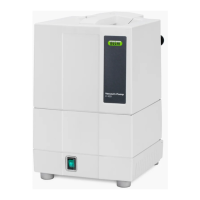
Do you have a question about the Buchi V-100 and is the answer not in the manual?
| Frequency | 50/60 Hz |
|---|---|
| Protection class | IP20 |
| Operating voltage | 230 / 115 V |
| Voltage | 230 / 115 V |
| Coolant temperature | 15 - 25 °C |
| Coolant consumption | 3 l/min |
| Overpressure at coolant outlet | 1 bar |
Explains danger levels, warning symbols, and their meanings for safe operation.
Covers mandatory symbols, other symbols, languages, and trademarks.
Defines correct applications, prohibited uses, and required personnel qualifications.
Addresses residual risks, dangerous vapors, faults, PPE, and modifications.
Explains the operational functions and modes of the Vacuum Pump V-100.
Identifies components on the front, rear, and internal views of the V-100.
Illustrates and describes a common laboratory setup using the V-100.
Explains the device's type plate and lists included components.
Details pump performance, operating conditions, and materials.
Provides guidelines for safely transporting and storing the device.
Explains how to remove temporary transit fixings before operation.
Highlights crucial safety warnings and precautions before initial setup.
Specifies site requirements and how to connect laboratory equipment.
Explains how to connect the silencer to the pump or secondary condenser.
Provides instructions for connecting a Woulff bottle to the V-100.
Explains how to fit and connect a secondary condenser to the V-100.
Details the procedure for connecting a secondary cooling cold trap.
Guides on making the necessary electrical connections for the V-100 and Interface I-100.
Covers fitting the holder and connecting the Interface I-100 to the V-100.
Describes how to operate the V-100 when controlled by the Interface I-100.
Explains how to operate the V-100 as a standalone device.
Covers general cleaning precautions, housing, and glass components.
Details cleaning procedures for the pump, tubing, valves, and membranes.
Guides on removing, dismantling, and reassembling the pump head.
Provides instructions and necessary tools for replacing the pump membrane.
Guides on how to replace the non-return valves in the pump head.
Details the steps for replacing the tubing within the pump head assembly.
Provides a table listing common faults, their causes, and solutions.
Outlines how to contact customer service for support, repairs, and advice.
Explains steps for safely decommissioning and disposing of the device.
Lists solvent properties, accessories, wear parts, and spare parts.
Provides abbreviations and procedures for health and safety declarations.
Provides a declaration form for hazardous material contact and safe disposal.